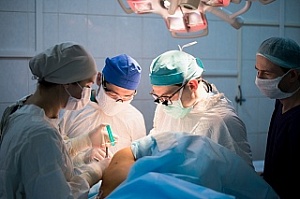taff at the Tomsk Scientific Research Institute of Oncology of the Tomsk Scientific and Technical Center, the first such center in Russia, have begun reconstructive and reparative operations for facial bone loss using 3D implants made of nanoceramics. The implant developers are scientists at the Laboratory of Medical Materials Science, which includes staff from the University, Institute of Strength Physics and Materials Science of the Siberian Branch of Russian Academy of Sciences (ISPMS SB RAS), and the Institute of Oncology. At the Laboratory, materials scientists make the designs that oncology surgeons use in the most complex clinical cases.
- Most often technical difficulties arise when working with the upper jaw, due to specific features of its anatomical structure,- says Denis Kulbakin, a senior research fellow at the Institute of Oncology of Tomsk National Research Medical Center. - The upper jaw has many bends, so it is impossible to fill in a missing fragment at the expense of the patient's “native” tissues.
Until recently, bone defects resulting from trauma or radical surgery were covered with prostheses made of plastic, polyethylene, titanium, and alloys. Metal implants are now about 70 percent of the total, but up to 40 percent are rejected because of inflammatory processes that occur. One of the reasons for this complication is that patients have previously undergone radiation and/or chemotherapy. Implants made of nanoceramics solve the problems of patient survival and anatomical similarity at the same time.
– In composition, this material resembles the native bone of the patient,- says Sergei Kulkov, head of TSU’s Laboratory of Medical Materials Science. - Oxides of zirconium, aluminum, and mixtures of them are used in its manufacture. They are safe for the body and are included in the international ISO register. To replicate the shape of the lost fragment, we create its prototype. We translate the CT scans of the patient into the format of a three-dimensional model of the skull.
Then, the developers print a prototype of the fragment and the hard tissues surrounding the defect from plastic on a 3D printer and try to fit it. At the final stage, the scientists create a matrix and fill it with a mixture of ceramic powder and polymers. After sintering, the finished implant is given to medical workers for sterilization.
The Laboratory of Medical Materials of TSU was created within the Project 5-100 and unites scientists of the University, ISPM SB RAS, and Tomsk Scientific Research Institute of Oncology. The laboratory has operated successfully for 4 years, in the consortium Network Center “Volume reconstruction of bone defects”, and it is a member of the StrAU Institute of Smart Materials and Technology (SMTI) and StrAU Institute of Biomedicine.
The first prosthesis made of porous nanoceramics was successfully installed in 2017 for a 26-year-old patient who lost part of the upper jaw due to osteogenic sarcoma. The results of the follow-up examination conducted several months later indicate that there is no inflammation in the implant attachment zone, that is, the new material has taken root and organically coexists with native tissues.
Such a surgical intervention was conducted for a patient with a diagnosis of upper-maxillary sinus cancer. Surgeons made a resection, and after some time the defects were closed with an implant, made in TSU’s laboratory, and soft tissues from the woman’s shin.
- In a few days, a recovery operation for a 25-year-old woman with a benign lower jaw tumor will be conducted, - says Denis Kulbakin. - The volume of the cyst completely destroyed the bone tissue. We will remove the damaged area and install the implant at the same time, so that the person will not have to live with a serious cosmetic defect.
According to medical experts, every year dozens of patients at the Oncology Research Institute need such operations. There are estimated to be thousands of such patients in the country, and the collaboration of oncologists and materials scientists will give them
Currently, scientists at the Oncology Research Institute are carrying out research on this topic. The result will be recommendations that will help other clinics introduce a new medical technology for the rehabilitation of cancer patients using nanoceramic implants.

